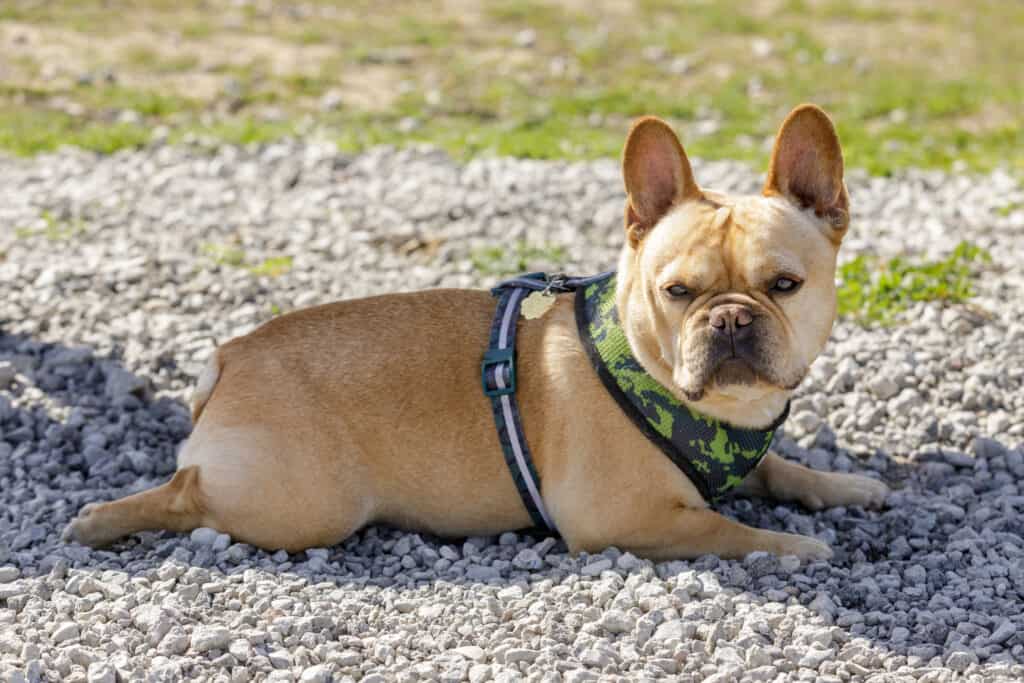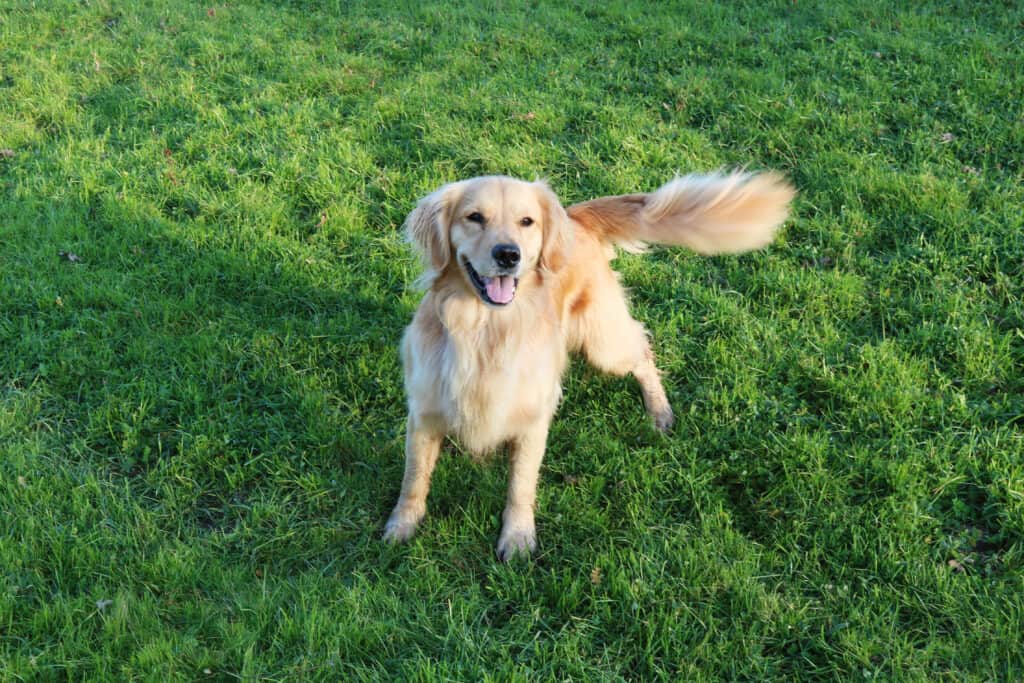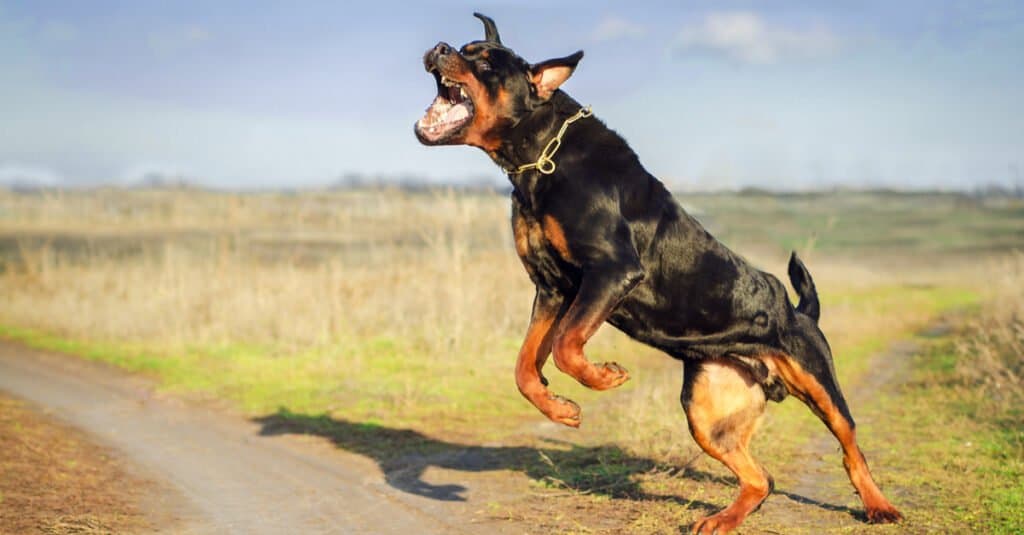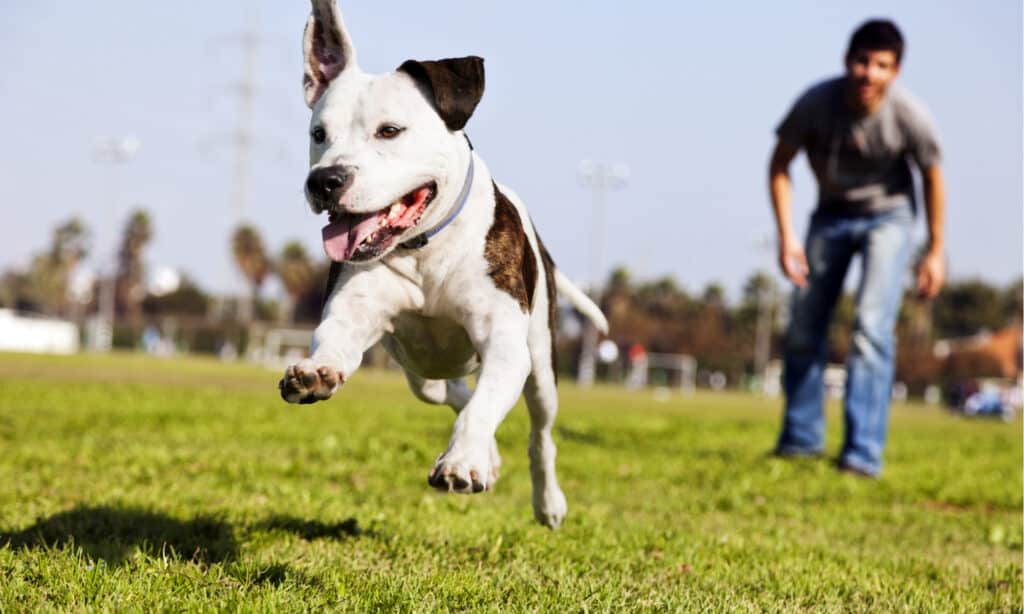Quick Answer:
- If your dog leans on you, it is signifying that it loves and trusts you and wants to be near you.
- Your dog could be leaning on you because it feels insecure or anxious.
- It could be that your dog is asking for something.
You’re lying on the couch, reading a book, or watching TV, and suddenly you feel a bit of weight on your lap. It’s probably your dog – it has found a way to get close to you and wants to be petted.
But why does your dog lean on you? What does it want?
While every dog is an individual, there are a few common reasons dogs lean on their owners. For example, they may be trying to say something about their feelings or what they need.
Here are some of the most common meanings for canine leaning.
1. A Sign of Affection

Your dog leans on you because it sees you as a pack member.
©4 PM production/Shutterstock.com
Your dog leans on you because it sees you as a pack member. Dogs are social animals that communicate and show affection to their pack.
If your dog leans on you, it is signifying that it loves and trusts you and wants to be near you. It is also a way for it to show that it is happy or excited to see you. Here are some easy ways to show love to your dog:
Petting
Petting is essential for dogs to communicate with their pack members. When dogs are happy or excited, they will often paw at their owner to get more petting from them. They may do this even if they aren’t hungry or thirsty, so ensure that you don’t take this gesture as an indication that your pets are hungry or thirsty.
Feeding
Dogs like food just like humans do. So giving them treats when they do something well is a great way to learn what behaviors are rewarded.
Playing
Playing with your dog can be rewarding because playing together helps strengthen your bond with it.
2. A Sign of Insecurity and Anxiety

Dogs suffering from stress, anxiety, and insecurities may lean on their owners.
©iStock.com/yhelfman
Dogs suffering from stress, anxiety, and insecurities may lean on their owners. For example, if your dog leans against you when strangers are around, it could mean it feels more secure with you. In addition, leaning against you while petting or walking may indicate that it feels happier close to you.
If your dog does this consistently, it could be because it has some anxiety problems. Several factors can contribute to this behavioral problem in dogs, including:
- Lack of socialization
- Lack of exercise
- Overcrowding
- Being left alone for long periods
- Moving to a new home
If this is the case, you must take steps to reduce your dog’s anxiety and stress levels as quickly as possible. This could involve keeping it active during the day. Giving it plenty of exercises also helps to keep it mentally stimulated. This helps reduce anxiety in your pet and helps to keep it healthy and relaxed. You can also ensure it has enough social time with other dogs and people, as this helps to reduce its anxiety about meeting others.
3. To Ask For Something
Dogs may lean on you if they are seeking something from you. For example, this could signify that they want to play or eat. If this is the case, paying attention to the position of their tail and ears when leaning toward you is essential.
They want to play if their tail wags and their ears are perked up. On the other hand, if these two signs are not present when your dog is leaning on you, it likely wants something else (like food).
4. A Sign of Dominance

Dogs have a pack mentality and want to be the pack’s leader.
©Pandas/Shutterstock.com
When a dog leans on you, it can be a sign of dominance. Dogs have a pack mentality and want to be the pack’s leader. They know that by leaning on you, they are showing that they are the dominant one in your relationship.
In the dog world, dominance is a complicated concept. A dominant dog doesn’t always act like an alpha; it’s not always apparent that a dog is being dominant. Some dogs are intentionally dominant, but others may just be doing what comes naturally to them.
Dealing with a dominant dog can be challenging because you’re trying to change something natural for your pet. There are ways you can overcome this problem without having to hire a dog whisperer.
Remain Calm
A dominant dog will challenge you if it sees you as weak or nervous. If you show fear or nervousness, this will encourage it to continue acting out. So stay calm and confident in its presence.
Set Boundaries
Dominant dogs are self-assured, so it’s essential to establish yourself as the alpha. You want to be assertive, not aggressive when you set boundaries. Dominant dogs will test your limits and see how far they can push you before you give up control.
Give Your Dog Enough Exercise
Dominant dogs need lots of exercise, so they don’t feel bored or frustrated with their environment. Ensure they get at least 30 minutes of exercise each day and make it fun by playing fetch, going for walks, or running around in an open field.
Be the Pack Leader
Be assertive and confident when you’re on a walk with your dog. For example, don’t let your dog go up to sniff another dog when it is approaching. Instead, keep your dog by your side and allow the other dog to come first.
Reward Good Behavior
When your dog behaves well on walks, reward it with praise or treats. This will help reinforce good behavior so that it continues to listen to you when out in public places.
How To Read Your Dog’s Body Language Like a Pro
The best way to understand your dog is to learn its body language. By understanding dog body language, you’ll better communicate with your pet and know when it requires attention or if something is bothering it. It also helps prevent misunderstandings and avoid potential conflicts.
1. A Happy Dog

A wagging tail is the most common sign that a dog is happy.
©Hollysdogs/Shutterstock.com
If your dog is happy, it will likely show it in various ways. Here are some signs that your dog is happy.
Tail Wagging
A wagging tail is the most common sign that a dog is happy. Of course, some dogs wag their tails more than others, but even if your dog’s tail doesn’t move much, it may still be happy.
Your Dog Will Lick You or Another Person
If your dog licks you when you greet it, it wants to cuddle with you. But don’t take anything for granted – just because your dog licks you doesn’t mean it is happy. Instead, it might be trying to show dominance or get something from you (like food).
Rolling Over Its Back and Exposing Its Belly – An Invitation for Belly Rubs!
Rolling over shows submission and trust, both signs of happiness in dogs.
Your Dog Will Jump Around Excitedly
Dogs can jump around when you come home from work or school each day. Of course, they also jump around when they’re excited about something else — like going for a walk or playing fetch — but this is one way dogs express excitement.
2. A Frightened Dog

Dogs can feel afraid around strangers, unfamiliar places, or other animals.
©Patrick H/Shutterstock.com
Loud noise, among other things, can frighten a dog. It can feel afraid around strangers, unfamiliar places, or other animals.
Because dogs are social animals and want to be part of the pack, they may feel anxious when left alone for long periods. This is particularly true for puppies.
You can tell if your dog is frightened by these signs:
Tail Tucked Between the Legs
The tail is an essential communication tool for dogs; if it is tucked between their legs, it means they are scared or anxious.
Whimpering or Whining
This type of vocalization usually means that your dog is uncomfortable or unhappy.
Panting Heavily
Wide eyes and dilated pupils indicate fear in dogs and other strong emotions such as excitement and anger.
3. Aggression

If you’re concerned that your dog may be aggressive, it’s essential to seek professional help.
©Olexandr Andreiko/Shutterstock.com
Aggression is a severe problem for dogs and their owners. Therefore, it’s essential to recognize the warning signs of aggression to take steps to deal with it before it becomes a severe issue.
If you’re concerned that your dog may be aggressive, it’s essential to seek professional help. Don’t try to handle the matter alone or wait until the situation escalates into something dangerous. An experienced dog trainer or behaviorist can help you identify the cause of your dog’s aggression and develop a plan for dealing with it.
The following are some signs that your dog could be aggressive:
Inappropriate Barking
It could signify aggression and fear if your dog constantly barks at other dogs or people.
Unexpected Lunging or Growling
If it is lunging and growling at people or other dogs, it could be sending messages to stay away.
Biting Without Warning or Provocation (Even in Play)
This is an obvious sign and something you want to avoid at all costs. Dogs will bite when they want to protect themselves. It could signify aggressiveness if this happens more often, even during play.
4. Time To Play

Most dogs have an innate desire to play with other dogs but can also enjoy playing with people.
©elbud/Shutterstock.com
Play is an integral part of a dog’s life. It strengthens the bond between you and your canine companion and helps it develop into a well-rounded dog.
Most dogs have an innate desire to play with other dogs but can also enjoy playing with people. Here are some signs that your dog wants to play.
Wagging of Tails
Dogs wag their tails when they’re happy, so this is one of the most apparent cues that your dog wants to play.
The Ears Go Up
If your dog’s ears are up and forward, it means it’s alert and attentive to its surroundings — perfect for playing!
The Paws Go Up
If your dog puts its paws up on you, it’s another sign that it wants to play. It can be a sign of affection as well as excitement about an upcoming activity.
The Dog Smiles
Dogs smile by showing their teeth, so look for this expression when trying to figure out if your pup wants to frolic around the living room floor.
Conclusion
In the end, empathy is at the heart of most dog interactions, whether social or intimate. These behaviors aren’t necessarily reserved for humans. A dog will lean on others if it trusts or feels close to them.
While a dog leaning on you may seem like nothing more than a warm, comfortable experience, remember that you are unique to your canine friend, and it can’t trust anybody other than you. So enjoy these moments, but always be mindful of needlessly straining your dog’s back.
The photo featured at the top of this post is © iStock.com/Arturo Rosenow
Ready to discover the top 10 cutest dog breeds in the entire world?
How about the fastest dogs, the largest dogs and those that are -- quite frankly -- just the kindest dogs on the planet? Each day, AZ Animals sends out lists just like this to our thousands of email subscribers. And the best part? It's FREE. Join today by entering your email below.
Sources
- The Spruce Pets, Available here: https://www.thesprucepets.com/why-do-dogs-lean-on-people-1118304#:~:text=Dogs%20lean%20on%20people%20because,they%20can%20to%20get%20close.
- Orvis, Available here: https://news.orvis.com/dogs/7-signs-of-affection-from-your-dog
- The Dodo, Available here: https://www.thedodo.com/dodowell/does-my-dog-love-me
Thank you for reading! Have some feedback for us? Contact the AZ Animals editorial team.






